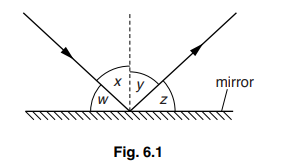Question
(a) Fig. 6.1 shows a plane mirror reflecting a ray of light.

(i) There is a dashed line drawn at right angles to the mirror.
State the name of this line.
(ii) State which angle, w, x, y, or z, is the angle of reflection.
(b) Fig. 6.2 shows a ray of white light entering a semi-circular glass block. The ray of light emerges at point R and travels alongside the flat surface.

A spectrum of colours can be seen on the screen between S and T.
(i) State the colours in the correct order. One has been done for you.
colour at S red
……………………….
colour at T …….
(ii) The angle of the ray is changed.
On Fig. 6.3, complete the path of the ray of light. Explain your answer.

Answer/Explanation
Answer:
(a) (i) (the) normal
(ii) y
(b) (i) (red), orange, yellow, green, blue, indigo, violet/purple
(ii) any three from:
(ON DIAGRAM) ray reflected
angle i = angle r (by eye)
explanation:
(incident angle) is greater than critical angle
(so there is) total internal reflection
Question
Fig. 6.1 shows a glass block ABCD surrounded by air. A ray of red light, PQ, is incident on face CD of the block.

(a) On Fig. 6.1,
(i) draw the normal at Q and the refracted ray inside the block so that it meets face AB,
(ii) draw the ray emerging from face AB of the block and the normal where the ray emerges,
(iii0 between the rays and the normals you have drawn, label two equal angles X.
(b) The angle of incidence of another red ray is 65°. The refractive index of the glass of block ABCD for red light is 1.62.
(i) Calculate the angle of refraction in the glass for this ray.
angle =
(ii) The speed of light in air is 3.0 × \(10^8\) m / s.
Calculate the speed of the red light in the glass.
speed =
(c)For the same angle of incidence, the angle of refraction of red light in glass is greater than the angle of refraction of violet light.
State the term which describes the separation of red and violet refracted rays in glass.
Answer/Explanation
Answer:
(a) (i) Normal at Q drawn AND refracted ray drawn with r less than i
(ii) Emerging ray drawn parallel to PQ AND normal drawn
(b) (i) n = sin i ÷ sin r in any form OR 1.62 = sin 65 ÷ sin r in any form
OR sin r = sin 65 ÷ 1.62
r = 34°
(ii) n = speed (of light) in air ÷ speed (of light) in glass in any form
OR 1.62 = 3.0 × \(10^8\) ÷ speed in glass in any form
(speed in glass = 3.0 × \(10^8\) ÷ 1.62) = 1.8 OR 1.9 × \(10^8\) m/s
(c) Dispersion
